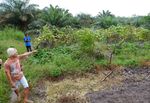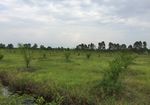Intercropping food and cash crops with oil palm - Experiences in Uganda and why it makes sense - Tropenbos ...
←
→
Page content transcription
If your browser does not render page correctly, please read the page content below
Policy Brief
March, 2021
Intercropping food and cash crops with oil palm –
Experiences in Uganda and why it makes sense
Expansion of oil palm production in Uganda has certainly brought economic benefits.
But these have been inequitably distributed and have been accompanied by negative
environmental and social impacts. This brief proposes different options that allow farmers
to overcome some of these impacts by mixing oil palm with other crops that can increase
smallholder incomes, resilience and biodiversity. It summarizes international experiences
supported by surveys that show that Ugandan farmers are already experimenting with
and adopting intercropping, and based on findings and lessons learned, offers specific
recommendations for the government, private sector, extensionists, and farmer associations.
General recommendations
1. Encourage smallholders to try different intercropping systems and adopt best management practices, to
improve crop diversity, and to provide a buffer to fluctuating prices of oil palm fresh fruit bunches.
2. Promoting intercropping with beans, yams, bananas, cassava, etc. in the first 4-5 years after planting, with no
competition noted, and farmers benefit from food and income before the first oil palm harvest.
3. Permanent intercropping is possible if alternative oil palm spacings are adopted at establishment, such as the
double row avenue (alley cropping) system, and planting of shade tolerant crops with good market prices
such as black or white pepper, vanilla, cacao, coffee or turmeric.
4. Other trees can be planted in older oil palm fields around plantations or in spaces but results are not yet
available from long term experiments on overall incomes from combining oil palm with timber trees.
5. Training is required to ensure than intercropping is planned and implemented as an organized system, lead-
ing to increased benefits.Intercropping oil palm in the first four to five years after tions than those who did not, producing annual crops
planting at the standard 9x9 metre spacing provides between the palm trees planted at the recommended
help to meet family food requirements and can provide 9x9m spacing, helping to meet family food requirements.
alternative incomes. Crop such as beans, maize, cassava, There was no observed negative effects on the growth
sweet potato, sugarcane and banana do not compete of oil palm or intercrops in the first 4-5 years. However,
when grown in the spaces between young oil palm. farmers were not aware of different planting systems, or
Where permanent intercropping is concerned, crop com- crops that could then survive within plantations over the
binations and adapted planting densities tested in other entire 25-year rotation, nor of the environmental, social
countries minimize yield losses for oil palm and intercrops, and economic benefits that this could offer. Others noted
or compensate by higher total income per hectare than the value of intercropping, but expressed concern about
from monocropping. Global experiences supported the lack of related training by their growers’ association,
by local surveys shows that intercropping makes sense, the KOPGT, that did encourage intercropping for the first
providing farmers with additional food and cash crops four years after establishment, but did not offer specific
while promoting multiple livelihood options that benefit training.
outgrowers, independent smallholders and oil palm com-
panies. But encouraging intercropping requires action by With permanent intercropping, crop combinations and
the main players – the Ministry of Agriculture, the donor planting densities need to be adapted to minimize oil
IFAD, the oil palm companies BIDCO and OPUL, and the palm yield losses and to ensure higher total incomes per
different producer associations. hectare compared to monoculture oil palm. Research is
ongoing in many countries with various crops, spacings
Methodology and combinations, though further experimentation is still
needed to develop the optimum systems for different sites,
The research behind this brief and associated publications situations and markets. However, Oil Palm Uganda Ltd
was the last in a series that started in 2018, and which (OPUL) has been discouraging intercropping as they con-
explored options to improve the environmental, health and sider that this negatively impacts oil palm yields and thus
food security benefits of oil palm production that is expand- company profits. But they should now acknowledge the
ing rapidly in Uganda. It sought to understand whether benefits and promote the practice, confirmed in reports
smallholder farmers already practice intercropping in oil from around the world.
palm plantations, and assess this in the context of similar
experiences around the world, leading to insights on mod- Once oil palm intercropping and agroforestry options for
els and systems that could be further applied in Uganda Uganda are developed, based on models summarized
and elsewhere. It involved quantitative and qualitative data in this brief, community mobilization and empowerment
collection in 2019, with in-depth surveys of farmer practices are required if the policy objective of developing both
in the islands of Kalangala district and on the mainland, food and commercial crops is to be achieved. This will not
complemented by a global literature review. Open-ended decrease overall production, and will likely increase total
questionnaires guided interviews with farmers practicing output and smallholder resilience. Ministries, donors and
intercropping or monocropping, and with others including companies responsible for the oil palm sector must work
extension workers from the Kalangala Oil Palm Growers to educate farmers on these various options and support
Trust (KOPGT) and Oil Palm Uganda Ltd (OPUL). Data services to promote intercropping alongside the produc-
was statistically analysed and supported by photography, tion of oil palm.
observations and voice recordings. This resulted in specific
recommendations to stakeholders in the National Oil Palm In conclusion, intercropped oil palm agroforestry provides
Programme (NOPP), presented at the end. alternative livelihoods, reduces dependency, spreads risks
and workloads, and diversifies incomes while also helping
Main findings to meet families’ nutritional needs, improves biodiversity,
and resilience to fluctuations in the price of fresh fruit
Palm oil has been produced in Kalangala since 2007, and
bunches. The models introduced in this brief are explained
plantations are expanding on other Lake Victoria islands
in more detail in an accompanying research paper, and a
and the mainland. Survey results showed that more
guide for extensionists and farmers.
farmers grew food crops within young oil palm planta-
A word on terminology – intercropping or agroforestry?
Strictly speaking, the term ‘intercropping’ is used to describe the system of growing of annual or short-lived crops
together on the same piece of land. But, when one of these ‘crops’ is a species of tree, whether they are young
seedlings or mature trees, then the system is generally called ‘agroforestry’. Though because this distinction is not so
clear with farmers and extensionists – and also not even amongst experts – both terms are used somewhat inter-
changeably here, as if they are the same ‘practice’.Suggested intercropping models growth. Between planting and the first oil palm harvest,
annual crops like maize and beans and perennials like
Intercropping in young oil palm plantations banana and pineapple can be grown to improve food
This is the most common intercropping system, during early security and family nutrition. Intercropping with legumes
oil palm development up to four or five years, allowing (beans, peas, soybeans, etc.) also increases soil fertil-
the production of food and cash crops. It provides food ity through nitrogen-fixation, and cover crops such as
and income before the first oil palm harvests, reduc- mucuna help to prevent soil erosion.
ing weeding costs, with no negative effects on oil palm
Intercropping in young oil palm plantations in Sumatra, Indonesia. A farmer shows food crops he produces, moving from one
young plantation to another (left); and a plantation owned by a large farmer who allows smallholders to grow rice in the first
few years after establishment (right). Photos: Thijs Pasmans
Permanent intercropping in double row avenue rows, while leaving 15 metre wide ‘avenues’ (see fig-
systems ure, below). This allows farmers to intercrop with various
combinations of high value crops such as cacao, coffee,
This is a developing model that allows the production of vanilla, fruit or timber trees, with minimum negative impacts
oil palm and other crops throughout the full 25-year cycle. on oil palm yields, and allows for a wider choice of crops
With a similar number of oil palm trees per hectare as in that can receive adequate light, water and nutrients.
the standard 9x9 metre monoculture, palms are planted
closer together in double rows at 6 metre spacing within
An example of permanent oil palm agroforestry, with black pepper in a double row avenue systemDouble row alley intercropping in Malaysia, with cassava (left) and black pepper (right). Photos: Maja Slingerland.
Boundary tree planting Multistory homegardens
This agroforestry model includes boundary trees around This is a common system in West and Central Africa,
oil palm plantations, and in drier areas this helps to where oil palm is native. Here, it is often found as just one
conserve moisture and reduces wind erosion. These trees species amongst many annual and perennial crops, mixed
provide firewood, wood for charcoal, posts, poles, timber, with fruit trees and livestock. This supports multiple liveli-
fruit or rubber depending on the species. This diversifies hood strategies, allowing smallholders to produce food,
production, improves biodiversity and nutrition cycling, feed, fuel, timber and animal products on small parcels
and by demarcating boundaries, can also reduce land of land, increasing resilience if one or other crop fails or
ownership conflicts. In some countries, trees are also inter- the price falls. All parts of the oil palm tree are used, and
planted within the plantation, though this tends to reduce fresh fruit bunches are usually processed for domestic use.
oil palm yields. Maximizing oil palm yield per hectare is not an objective.
Specific recommendations
For the Ministry of Agriculture, IFAD, BIDCO, OPUL, the National Crops Resources Research Institute of the National
Agricultural Research Organisation (NARO) and producer associations.
1. Promote the growing of food and cash crops in young plantations in the first 4-5 years after planting.
2. Increase the extension and training available to outgrowers and smallholders on oil palm intercropping and suit-
able agroforestry systems, best practices and crops, and provide planting material and support for marketing.
3. Incentivize the adoption of alternative planting systems and permanent intercropping, that provide more diverse
economic and environmental benefits and better meet farmers’ needs.
4. Invest in research and establish demonstration plots using double row alley systems, boundary tree planting and
other mixed cropping systems.
This brief has been produced under the framework of the Green Livelihoods Alliance - Millieudefensie, IUCN NL and Tropenbos International,
funded under the ‘Dialogue and Dissent’ strategic partnership with the Netherlands Ministry of Foreign Affairs. The opinions and views expressed in
this publication are the sole responsibility of the authors and do not necessarily reflect those of Ecological Trends Alliance, Tropenbos International
or their partners. Texts may be reproduced for non-commercial purposes, citing the source.
Namanji S, C. Ssekyewa and M. Slingerland. 2021. Intercropping food crops into oil palm plantations – Experiences in Uganda and why it makes
sense. Policy brief. Ecological Trends Alliance, Kampala, Uganda, and Tropenbos International, Ede, the Netherlands. 4pp.
This brief is based on a research paper: Namanji S, C. Ssekyewa and M. Slingerland. 2020. Oil
palm intercropping in Uganda – an assessment of farmer practices and suggestion of alternatives.
Ecological Trends Alliance: Kampala, Uganda and Tropenbos International: Wageningen, the
Netherlands. 24pp. See also the related field guide: ‘Oil Palm Agroforestry: How to intercrop food,
fuel and other cash crops in and around plantations. A guide for extensionists and farmers’. Both are
available on www.tropenbos.org/resources. For more information, contact: Richard Ssemmanda
(richard@ecotrendsalliance.org) and Michael Opige (michael@ecotrendsalliance.org).You can also read























































